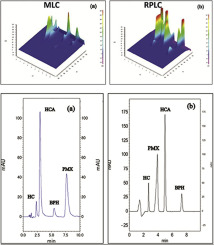当前位置:
X-MOL 学术
›
J. Food Drug Anal.
›
论文详情
Our official English website, www.x-mol.net, welcomes your
feedback! (Note: you will need to create a separate account there.)
Comparative study of two different chromatographic approaches for quantitation of hydrocortisone acetate and pramoxine hydrochloride in presence of their impurities
Journal of Food and Drug Analysis ( IF 2.6 ) Pub Date : 2018-07-01 , DOI: 10.1016/j.jfda.2017.12.008 Fawzia Ibrahim 1 , Asmaa Kamal El-Deen 1, 2 , Kuniyoshi Shimizu 2
Journal of Food and Drug Analysis ( IF 2.6 ) Pub Date : 2018-07-01 , DOI: 10.1016/j.jfda.2017.12.008 Fawzia Ibrahim 1 , Asmaa Kamal El-Deen 1, 2 , Kuniyoshi Shimizu 2
Affiliation

|
In the present study, we compare the performance of two reversed-phase liquid chromatographic approaches using different eluents either conventional hydro-organic eluent or micellar one for simultaneous estimation of hydrocortisone acetate and pramoxine hydrochloride in presence of their degradants and process-related impurities; hydrocortisone and 4-butoxyphenol, respectively. For conventional reversed-phase liquid chromatography (RPLC), separation of the studied compounds was completed on an Inertsil ODS 3-C18 column (150 mm × 4.6 mm, 5 μm particle size) with a mobile phase consists of 50 mM phosphate buffer (pH 5.0): acetonitrile (50: 50, v/v). For micellar liquid chromatography (MLC), an Eclipse XDB-C8 column (150 mm × 4.6 mm, 5 μm particle size) was chosen for the separation with a green mobile phase consists of 0.15 M sodium dodecyl sulfate, 0.3% triethylamine and 10% n-butanol in 20 mM orthophosphoric acid (pH 5.0). Both methods were extended to analyze hydrocortisone acetate and pramoxine hydrochloride in their co-formulated cream. RPLC was superior to MLC with regard to sensitivity for the estimation of impurities. While, MLC represents an eco-friendly, less hazardous and biodegradable approach. Furthermore, the direct injection of the cream to the system without the need to laborious samples pretreatment, excessive amount of analysis time and/or use of large amount of toxic organic solvents is one of the outstanding advantages of MLC.
中文翻译:

醋酸氢化可的松和盐酸普莫辛存在杂质时两种不同色谱方法的比较研究
在本研究中,我们比较了两种反相液相色谱方法的性能,使用不同的洗脱液(常规的水合有机洗脱液或胶束洗脱液)在醋酸氢化可的松和盐酸普莫辛存在降解物和工艺相关杂质的情况下同时测定其含量;分别为氢化可的松和 4-丁氧基苯酚。对于常规反相液相色谱 (RPLC),研究化合物的分离在 Inertsil ODS 3-C18 柱(150 mm × 4.6 mm,5 μm 粒径)上完成,流动相由 50 mM 磷酸盐缓冲液(pH 5.0): 乙腈 (50: 50, v/v)。对于胶束液相色谱 (MLC),选择 Eclipse XDB-C8 柱(150 mm × 4.6 mm,5 μm 粒径)进行分离,绿色流动相由 0.15 M 十二烷基硫酸钠组成,0.3% 三乙胺和 10% 正丁醇的 20 mM 正磷酸 (pH 5.0)。这两种方法都扩展到分析其共同配制的乳膏中的醋酸氢化可的松和盐酸普莫辛。RPLC 在杂质估计的灵敏度方面优于 MLC。同时,MLC 代表了一种环保、危害较小且可生物降解的方法。此外,无需费力的样品预处理、过多的分析时间和/或使用大量有毒有机溶剂即可将乳膏直接注入系统,这是 MLC 的突出优势之一。RPLC 在杂质估计的灵敏度方面优于 MLC。同时,MLC 代表了一种环保、危害较小且可生物降解的方法。此外,无需费力的样品预处理、过多的分析时间和/或使用大量有毒有机溶剂即可将乳膏直接注入系统,这是 MLC 的突出优势之一。RPLC 在杂质估计的灵敏度方面优于 MLC。同时,MLC 代表了一种环保、危害较小且可生物降解的方法。此外,无需费力的样品预处理、过多的分析时间和/或使用大量有毒有机溶剂即可将乳膏直接注入系统,这是 MLC 的突出优势之一。
更新日期:2018-07-01
中文翻译:

醋酸氢化可的松和盐酸普莫辛存在杂质时两种不同色谱方法的比较研究
在本研究中,我们比较了两种反相液相色谱方法的性能,使用不同的洗脱液(常规的水合有机洗脱液或胶束洗脱液)在醋酸氢化可的松和盐酸普莫辛存在降解物和工艺相关杂质的情况下同时测定其含量;分别为氢化可的松和 4-丁氧基苯酚。对于常规反相液相色谱 (RPLC),研究化合物的分离在 Inertsil ODS 3-C18 柱(150 mm × 4.6 mm,5 μm 粒径)上完成,流动相由 50 mM 磷酸盐缓冲液(pH 5.0): 乙腈 (50: 50, v/v)。对于胶束液相色谱 (MLC),选择 Eclipse XDB-C8 柱(150 mm × 4.6 mm,5 μm 粒径)进行分离,绿色流动相由 0.15 M 十二烷基硫酸钠组成,0.3% 三乙胺和 10% 正丁醇的 20 mM 正磷酸 (pH 5.0)。这两种方法都扩展到分析其共同配制的乳膏中的醋酸氢化可的松和盐酸普莫辛。RPLC 在杂质估计的灵敏度方面优于 MLC。同时,MLC 代表了一种环保、危害较小且可生物降解的方法。此外,无需费力的样品预处理、过多的分析时间和/或使用大量有毒有机溶剂即可将乳膏直接注入系统,这是 MLC 的突出优势之一。RPLC 在杂质估计的灵敏度方面优于 MLC。同时,MLC 代表了一种环保、危害较小且可生物降解的方法。此外,无需费力的样品预处理、过多的分析时间和/或使用大量有毒有机溶剂即可将乳膏直接注入系统,这是 MLC 的突出优势之一。RPLC 在杂质估计的灵敏度方面优于 MLC。同时,MLC 代表了一种环保、危害较小且可生物降解的方法。此外,无需费力的样品预处理、过多的分析时间和/或使用大量有毒有机溶剂即可将乳膏直接注入系统,这是 MLC 的突出优势之一。










































 京公网安备 11010802027423号
京公网安备 11010802027423号